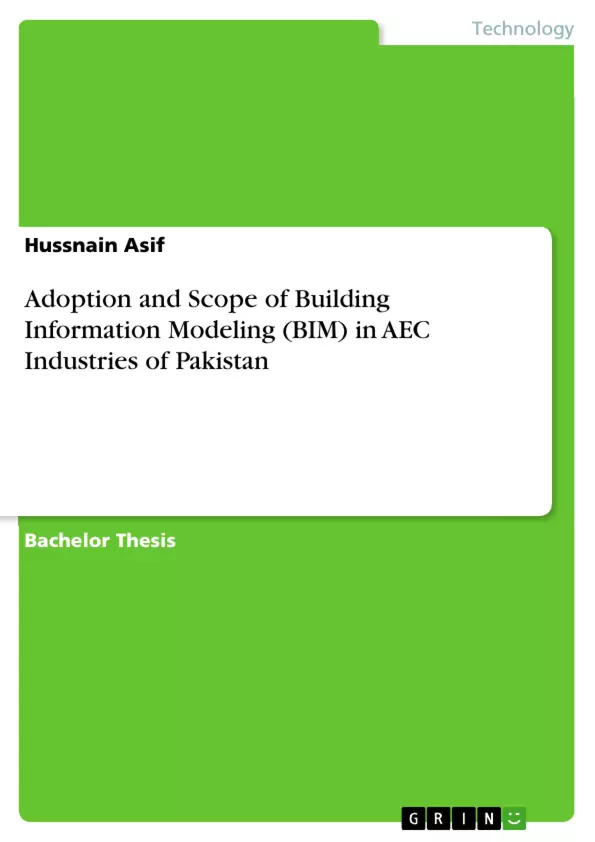This paper examines the implementation of building information modeling (BIM) in AEC industries. Various initiatives and approaches are used in different countries to promote the BIM implementation in their AEC industries. The real implementation and use of BIM remains a major concern of the AEC industry. This study investigates the implantation of BIM globally, in developed countries and the percentage of implementation of BIM in AEC industries of Lahore, Pakistan. This research demonstrates 200 responses from BIM users regarding BIM implementation whose collaboration aspects produce the highest positive impact. The adopted methodology is an online questionnaire survey and literature review which was conducted to find out the implementation of BIM in construction industries of developed countries.
Inhaltsverzeichnis (Table of Contents)
- INTRODUCTION
- 1.1 Background
- 1.2 Problem Statement
- 1.3 Objectives
- V2 LITERATURE REVIEW
- 2.1 History of BIM
- 2.2 The Components of BIM
- 2.3 Benefits of BIM
- 2.4 Limitation factor of BIM Implementation
- 2.4.1 Technological factor
- 2.4.2 Cost factors
- 2.4.3 Management factors
- 2.4.4 Personal factors
- 2.4.5 Legal factors
- 2.5 BIM future challenges
- 2.6 Adoption of BIM
- 2.7 Adoption of BIM in Pakistan
- 3 RESEARCH AND METHODOLOGY
- 3.1 Introduction
- 3.2 The Questionnaire
- RESULTS AND DISCUSSION
- 4.1 Results & Analysis
- 4.2 Sustainability Research od Adoption of BIM
- 4.2.1 Economics Aspect
- 4.2.2 Environmental Aspect
- 4.2.3 Social Aspect
Zielsetzung und Themenschwerpunkte (Objectives and Key Themes)
This project aims to explore the implementation of Building Information Modeling (BIM) in the Architecture, Engineering, and Construction (AEC) industries, particularly focusing on the adoption of BIM in Lahore, Pakistan. The study investigates the global trends of BIM adoption in developed countries and compares them to the local context of Pakistan.
- Global implementation of BIM in AEC industries
- Adoption and use of BIM in developed countries
- Factors influencing BIM adoption in Lahore, Pakistan
- Benefits and limitations of BIM implementation
- Sustainability aspects of BIM adoption
Zusammenfassung der Kapitel (Chapter Summaries)
The first chapter introduces the background of BIM and the problem statement, outlining the need for research into its implementation in Pakistan. The second chapter provides a comprehensive literature review, delving into the history of BIM, its components, benefits, and limitations. It further examines challenges associated with future implementation and explores the global adoption of BIM, highlighting its implementation in Pakistan specifically. Chapter three outlines the research methodology, including the questionnaire used to gather data from BIM users. Finally, the fourth chapter presents the results and discussion of the research, focusing on the analysis of the collected data.
Schlüsselwörter (Keywords)
Building Information Modeling (BIM), AEC Industries, Adoption, Implementation, Lahore, Pakistan, Sustainability, Benefits, Limitations, Global Trends, Online Questionnaire Survey, Literature Review.
- Arbeit zitieren
- Hussnain Asif (Autor:in), 2020, Adoption and Scope of Building Information Modeling (BIM) in AEC Industries of Pakistan, München, GRIN Verlag, https://www.grin.com/document/910053



